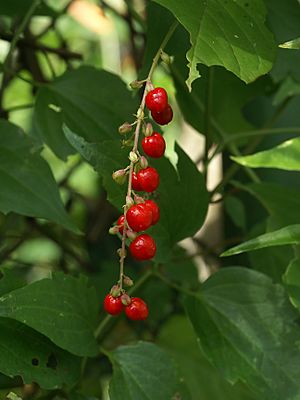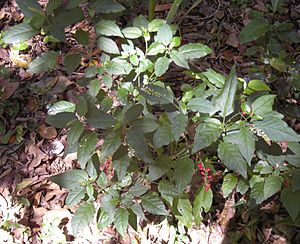Pigeonberry facts for kids
Quick facts for kids Pigeonberry |
|
|---|---|
 |
|
| Scientific classification | |
| Genus: |
Rivina
|
| Species: |
humilis
|
| Synonyms | |
|
Rivina laevis L. |
|
Rivina humilis is a type of flowering plant that belongs to the Petiveriaceae family. It used to be part of the pokeweed family. You can find this plant in the southern United States, the Caribbean, Central America, and warm, tropical parts of South America. People call it by many names, like pigeonberry, rougeplant, baby peppers, bloodberry, and coralito. Its scientific name, humilis, means "small" or "low-growing" in Latin, which describes how short the plant is.
Contents
What Does Pigeonberry Look Like?
Pigeonberry is a plant that stands upright and can sometimes grow like a small vine. It usually reaches a height of 0.4 to 2 meters (about 1.3 to 6.5 feet). This plant stays green all year and lives for many years. Its leaves can be up to 15 cm (6 inches) wide and 9 cm (3.5 inches) long.
The plant produces small flowers in clusters that are 4 to 15 cm (1.5 to 6 inches) long. The tiny, leaf-like parts that protect the flower buds are about 1.5 to 3.5 mm long and can be white, green, pink, or purplish. After the flowers, the plant grows shiny, bright red berries. These berries are small, about 2.5 to 5 mm (0.1 to 0.2 inches) across.
Where Does Pigeonberry Grow?
You can find Rivina humilis in many different places. It grows in forests, thick bushes, and even in places where old shells have piled up. It also likes roadsides and areas where the ground has been disturbed. This plant can grow from sea level up to 1,700 meters (about 5,577 feet) high.
Pigeonberry doesn't need a lot of sunlight and can even grow in full shade. It can also handle salty conditions, like near the ocean or in salty soils.
Sometimes, this plant can spread quickly and take over areas where it's not native. For example, it is considered an invasive plant in New Caledonia, where it was likely brought in around 1900. It's also seen as a weed in Queensland, Australia, and has spread to places like the Cocos Islands, Réunion, Norfolk Island, Fiji, Tonga, French Polynesia, Hawaii, and the Galapagos Islands.
How Do People Use Pigeonberry?
People grow Pigeonberry as an ornamental plant in warm parts of the world because it's so pretty. It's also valued because it can grow well in the shade and spreads out low to cover the ground. Some people even grow it as a houseplant or in greenhouses.
In the past, the juice from the berries was used as a dye and ink. The berries have a special red color called rivianin or rivinianin. This color is very similar to the red color found in beets. The fruit also contains another special yellow color called humilixanthin.
Tests have shown that the berry juice is safe to eat.
Pigeonberry in Nature
Rivina humilis is an important plant for some animals. It serves as a food source for the caterpillars of a butterfly called Goodson's greenstreak (Cyanophrys goodsoni).


